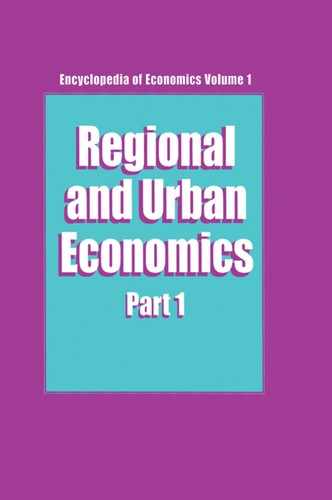Contents
GENERAL EQUILIBRIUM IN SPACE AND AGGLOMERATION
1. Spatially Separated Markets
2. Introducing Location Choice
2.1. The model: classification of problems
2.2. The first welfare theorem
4.1. The second welfare theorem
4.2. Equilibrium: the separable case
4.3. The club assignment problem
SPATIAL COMPETITION AND THE LOCATION OF FIRMS
by Jean Jaskold Gabszewicz and Jacques-François Thisse
3. The Basic Ingredients of Spatial Competition
3.2. The structure of demand in the industry
3.3. The definition of equilibrium in the industry
4. Spatial Oligopolistic Competition
4.1. Variable prices and parametric locations
4.2. Variable locations and parametric prices
4.3. Variable prices and locations
5. Spatial Competition with Free Entry
5.1. Spatial monopolistic competition
6. Reformulations and Conclusions
1. Basic Theory of Residential Land Use
1.1. Locational choice of the household
1.3. Optimal land use, optimal vs. equilibrium
2. Residential Land Use with Externalities
2.1. Local public goods and location of public facilities
2.2. Neighborhood externalities
2.3. Transport congestion and land use for transport
3.1. Prototypes of general equilibrium models
3.3. Spatial externality models: Type B
3.4. Imperfect competition model: Type C
4.1. Prototypes of dynamic models
4.4. Urban renewal, filtering process, and land development under uncertainty
4.5. Suggestions for further research
2. Externalities between Producers and Households
3. Externalities among Households
4. Externalities among Producers
5. Externalities Associated with Urban Transportation
6. Measuring the Benefits and Costs of Externalities
URBAN TRANSPORTATION ECONOMICS
1.1. The scope of urban transportation economics
2.3. Examples of disaggregate models
2.4. Assessment of travel-demand models
3.1. The nature of cost functions
3.2. Cost functions for public transit
3.3. Highway travel: congestion technology
3.4. Highway travel: short-run variable costs
3.5. Highway travel: long-run costs
3.6. Intermodal cost comparisons
4. Pricing, Investment, and Industrial Organization
4.1. Congestion pricing of highways
4.3. Pricing of public transit
4.4. Capacity choice for highways
4.6. Regulation and private provision of transportation
5. Conclusion: Toward Unified Models of Urban Transportation
Appendix: Long-Run Cost Functions with Queueing and Endogenous Scheduling
Selected Symbols and Abbreviations
by Pierre Hansen, Martine Labbé, Dominique Peeters and Jacques-FrançoisThisse
1. Facility Location in Continuous Spaces
1.5. The multifacility location problem
1.6. The location of an obnoxious facility
2. Facility Location in Finite Spaces
2.2. The uncapacitated facility location problem (UFLP)
2.7. Spatial-interaction-based allocation models
3. Facility Location on Networks
3.5. The multifacility location problems
SYSTEMS OF CITIES AND INTER-CITY TRADE
1. Cities and the structure of the economy
2. Basic properties of a system of cities
3. Economic growth and international trade
